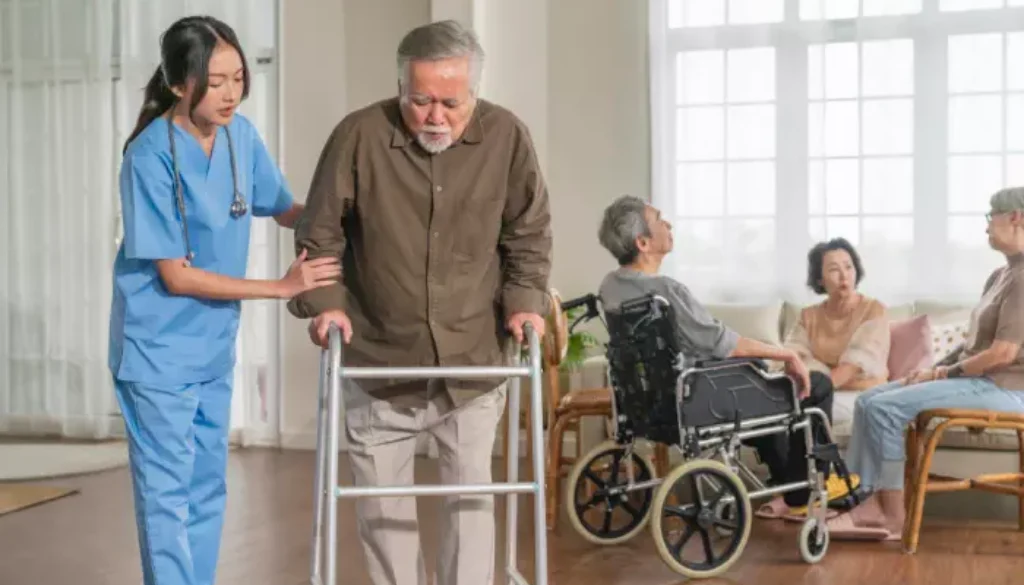Walking Assistance Devices for Seniors
Last Updated on January 27, 2024 by Rachel
Mobility aids and walking aids are made to assist elderly people who have trouble getting around safely. Various assistive walking devices have been developed to offer safety and assistance to seniors who need it because falls can be dangerous and the likelihood of falling increases significantly as one ages. You can be sure to find a walking aid that is best suited to your needs with the right direction and assistance. This article gives you an in-depth look at these gadgets so you can decide which one best suits your needs.
Types of Assistive Walking Devices for Seniors
(And the best to choose from each)
Canes
These are the most typical and widely-used kind of walking aid that an elderly person will probably use. They are easily portable, contribute to stability, and ease leg fatigue. By shifting a portion of the weight from the legs to the upper body, they also assist in supporting the body’s weight. The majority of canes have a standard length, but some can be customized to the user’s requirements.
The common forms of canes include;
- Quad canes – they are heavier and more stable with four feet at the bottom of the stick, making them an excellent walking aid for those with more severe balance/stability issues.
- Forearm canes – they are frequently referred to as crutches, and they provide additional forearm support by having an extension that shifts some of the weight from the wrists and hands to the upper arm.
- Adjustable canes are useful in some situations, but they are typically less stable than standard canes.
Best Cane for the Elderly – Hurricane Freedom Edition Folding Cane
The base of this cane is wide for all-terrain traction. The pivoting design offers balance and stability and is generally quiet when in use. Additionally, it features a comfort-fit, shock-absorbing handle and is quickly and easily foldable. It supports weights up to 350 lbs. (159 kg) and has a height range of 30.5″–37.5″. Additionally, it can be customized to your preferred color scheme and includes extras like a wrist strap and a travel bag.
Pros
- It is height-adjustable
- Has a sturdy comfortable handle
- Has a grippy base
Cons
- It is brittle and prone to breaking
- Unfolding can sometimes be difficult
- It is relatively costly compared to other canes
Learn more about this cane at https://www.hurrycane.com/products/hurrycane-freedom-edition.
Crutches
Crutches also shift some of the weight away from the legs and toward the upper body. They are typically much more obstructive, heavy, and challenging to use than standard canes, and are frequently used by the elderly in pairs.
They are commonly used following a leg injury because they work best as a temporary walking aid. However, they are often better options for long-term use.
Best Crutches for the Elderly – Medline Aluminum Forearm Crutches
Due to their sturdy construction from strong, heavy-wall aluminum tubing, they have a light, maneuverable design. To increase user comfort, the arm cuffs are vinyl-coated and tapered.
Additionally, they are available in three different sizes, with each one having a weight capacity of 250 lbs. (113 kg) and an adjustable height range of 4’2″ to 6’6″. Its innovative design uses internal bushings and exterior lock nuts making it silent when in use.
Pros
- They are lightweight, comfortable and of high-quality
- They stay on the arm when reaching for something
- Their height adjustment is simple
Cons
- The cuffs are too big for some users
- On wet surfaces, the tips might become a little slippery
To find out more about these forearm crutches, check out https://athome.medline.com/en/medline-aluminum-forearm-crutches-shop-all-pf04774.
Walker/Zimmer frames
They have four metal legs and sometimes wheels on the front two to facilitate forward motion. They come in a variety of styles, like 2-wheel and rollator walkers. Due to their much wider ground contact than canes and crutches, they offer more stability and balance. Additionally, they are typically portable and foldable. However, they might be challenging to maneuver outside, on high pavement, and around other similar obstacles.
A rollator’s frame has four wheels, handlebars, and frequently a seat so the user can take breaks as needed. Given the number of wheels, they typically have hand brakes for added security. They are particularly helpful for seniors who require more walking assistance than the average person but do not consider a wheelchair at the time.
Best Walkers for Seniors – NOVA Vibe 6 Rollator Walker
They have wheels on all four legs making movement easier and more convenient. The handles are height adjustable and hold brakes that are uniquely designed for maximum comfort and control, and easy to engage. Locking or parking the brakes requires only a gentle downward push on the lever and an upward pull to release. It has a padded seat that is comfortable and easy to clean. They can hold weights of up to 300 lbs. (136 kg).
Pros
- They come in vibrant colors
- They have durable wheels
- They have feather-touch locking hand brakes
- They have a padded seat and a storage pouch below
Cons
- Their product dimensions might not tally with other users’ body dimensions
Find out more about this walker at https://novamedicaldealer.com/collections/walkers.
Knee Scooters
Knee scooters are made to allow the user to propel with one leg while resting one knee on a padded cushion. Seniors who have only suffered a single leg injury or want a walking aid that keeps them active will find them especially helpful. Although they’re entertaining to use, they’re probably not the best choice for those with general weakness or restricted mobility.
Best Knee Scooter for the Elderly – KneeRover GO Knee Walker
This steerable, portable mobility aid is made for seniors who are constantly on the go. It is portable and foldable, making it lightweight and simple to transport. It also has thick contoured knee platforms that are compatible with either the left or right leg, smooth shock-absorbing rubber wheels, and is excellent for both indoor and outdoor use. It also includes tool-free setup and assembly and can support weights of up to 300 lbs. (136 kg).
Pros
- It is an excellent alternative to crutches
- Is stable and can easily be controlled
- Is lightweight and easily portable
- It is fully adjustable
Cons
- The seat is not height adjustable and might be incompatible with some users
Check out this knee scooter at https://kneerover.com/products/kneerover-go-knee-walker-knee-scooter.
Wheelchairs and Mobility Scooters
Seniors who shouldn’t or can’t exert weight on their lower limbs or those who are unable to walk should use wheelchairs. For those with more severe disabilities or those who must travel farther distances, a wheelchair may be the best mobility aid.
Mobility scooters are made to be used outside, much like wheelchairs. They have steering controls and are battery-powered. They are excellent for elderly people who have difficulty getting around.
Best Wheelchairs for the Elderly – Feather Chair 13.5 lbs.
This wheelchair is portable, foldable, and small in size. Additionally, this facilitates pushing and propulsion. The larger, back wheels can be easily removed with the push of a button thanks to optional, quick-release wheels. Wheel assembly and disassembly are both quick and simple processes.
It also comes with handbrakes that give the caregiver or helper control, security, and convenience when going down or stopping on a slope, as well as wheel locks that stop the wheelchair from rolling forward or backwards. It has a weight capacity of 250 lbs. (113 kg).
Pros
- It features a sleek ultra-light design making it easily portable
- The seat is soft, cushioning and comfortable
- It is easily foldable
Cons
- It is expensive
Other options for Walking Assistance
Ramps
They greatly facilitate access and are crucial for older adults who use wheelchairs, walkers, scooters, crutches and canes.
Stairlift
They allow easy access to different floors of a house or office without having to climb stairs.
Handrails
They can be installed almost anywhere, such as toilets, bathtubs, and other areas within a home or office, to reduce the risk of falling and provide assistance when moving around.
Disabilities or reduced mobility are results from falling, requiring the elders to use walking devices later on. Preventing Falls for Seniors and Having an Alarm System is a preventive measure to somehow avoid further damages. There are Fall Detection Devices that are also useful to immediately notify others if the seniors need urgent help.







